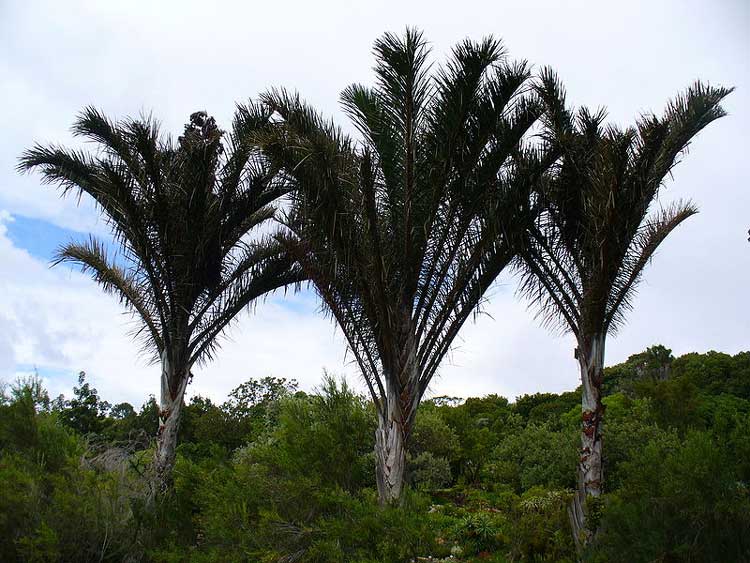
Raphia australis
Classification System: APG IV
Superregnum: Eukaryota
Regnum: Plantae
Cladus: Angiosperms
Cladus: Monocots
Cladus: Commelinids
Ordo: Arecales
Familia: Arecaceae
Subfamilia: Calamoideae
Tribus: Lepidocaryeae
Subtribus: Raphiinae
Genus: Raphia
Species: Raphia australis
Name
Raphia australis Oberm. & Strey, 1969.
Distribution
Native distribution areas:
Continental: Africa
Regional:Southern Africa
Cape Provinces; KwaZulu-Natal; Mozambique
References: Brummitt, R.K. 2001. TDWG – World Geographical Scheme for Recording Plant Distributions, 2nd Edition
References
Obermeyer, A.A. & Strey, R.G. 1969. "A new species of Raphia from northern Zululand and southern Mozambique". Bothalia 10: 29–37.
Links
Govaerts, R. et al. 2018. Raphia australis in World Checklist of Selected Plant Families. The Board of Trustees of the Royal Botanic Gardens, Kew. Published on the internet. Accessed: 2018 Dec. 13. Reference page.
International Plant Names Index. 2018. Raphia australis. Published online. Accessed: Dec. 13 2018.
The Plant List 2013. Raphia australis in The Plant List Version 1.1. Published on the internet. Accessed: 2018 Dec. 13.
Tropicos.org 2018. Raphia australis. Missouri Botanical Garden. Published on the internet. Accessed: 2018 Dec. 13.
Vernacular names
English: Giant Palm, Giant Raffia
Raphia australis, the giant palm or rafia, is a species of raffia palm in the family Arecaceae. It is found around Kosi Bay in southern Mozambique and northeastern KwaZulu Natal in South Africa. It is threatened by habitat loss caused by drainage of its habitat for agriculture; it is being threatened in the Bobole Special Reserve but is more secure in the Kosi Bay area.
Description
Raphia australis
Raphia australis is a large palm with a single trunk, growing to a height of 24 m (80 ft). The leaves are long and arching, the bases of the leaf stalks sheathing the trunk. The leaves are pinnate, the centre stem or rachis being robust and brown, while the leaflets have a single fold and are shiny green above and waxy and bluish-green below. The main veins and the margins of the leaflets are spiny. This palm was for a long time thought to be the same species as Raphia vinifera, but that has proved not to be the case, the most obvious difference being that the flower stems of R. australis are erect while those of R. vinifera dangle downwards.[2]
Distribution and habitat
Raphia australis is endemic to Gaza Province in southern Mozambique and near Kwangwanase at Kosi Bay in KwaZulu Natal in South Africa. There are four subpopulations, the largest one being at Manhiça District in Mozambique where there are about 4,000 mature individuals. This palm grows in swamps, peat bogs and seasonally flooded dunes.[1]
Ecology
Raphia australis flowers when it is between twenty and forty years old, sets fruit and dies, although the dying process may take up to three years. The tree has specialised aerial roots known as pneumatophores to help it to breathe.[1] The seeds are eaten and dispersed by the palm-nut vulture, which is widespread in other coastal regions of Africa but in southern Africa only occurs in association with this palm.[3]
References
Matimele, H.A.; Massingue, A.O.; Raimondo, D.; Bandeira, S.; Burrows, J.E.; Darbyshire, I.; Timberlake, J. (2016). "Raphia australis". IUCN Red List of Threatened Species. 2016: e.T30359A85955288. doi:10.2305/IUCN.UK.2016-3.RLTS.T30359A85955288.en. Retrieved 15 November 2021.
Brink, M.; Achigan-Dako, E.G. (2012). Fibres. PROTA. p. 399. ISBN 978-92-9081-481-8.
Gidlow, R.M. (2002). "The history of exchange controls in South Africa". South African Journal of Economic History. 17 (1–2): 25–48. doi:10.1080/10113430209511143. ISSN 1011-3436. S2CID 153424887.
"Raphia australis". PlantZAfrica.com. Retrieved 2010-02-11.
Retrieved from "http://en.wikipedia.org/"
All text is available under the terms of the GNU Free Documentation License

